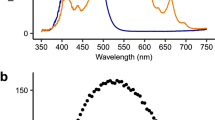Abstract
The influence of salinity on the growth, gross chemical composition and fatty acid composition of three species of marine microalgae,Isochrysis sp.,Nannochloropsis oculata andNitzschia (frustulum), was investigated. There was no significant change in growth rate ofIsochrysis sp. andN. (frustulum) over the experimental range of salinity (10–35 ppt), whileN. oculata had a significantly slower growth rate only at 35 ppt. The ash content of all three species increased with increasing salinity. Two species,Isochrysis sp. andN. oculata, showed significant linear increases in total lipid content with increasing salinity over the range 10 to 35 ppt.N. (frustulum) showed significant linear decrease in total lipids, with the highest percentage at low salinity within the range 10–15 ppt. Variation in salinity had only a slight effect on the total protein, the soluble carbohydrate and chlorophylla content of all species. All species responded to change in salinity by modifying their cellular fatty acid compositions. Significant positive correlations were observed between increase in salinity and increase in the percentage ofcis-9-hexadecenoic acid [16:1 (n-7)] over the entire experimental range inN. (frustulum) and between 25–35 ppt inN. oculata. There were curved relationships between salinity and percentage of hexadecanoic acid [16:0] inN. oculata andN. (frustulum), with maxima within the range 25–30 ppt for both species. A curved relationship was found between salinity and percentage of eicosapentaenoic acid [20–5(n-3)], forN. (frustulum), with lowest percentages of the fatty acid within the range 25–30 ppt. There was no consistent pattern in the percentages of other major fatty acids as functions of salinity. The Northern Territory isolateN. (frustulum) was unusual in having a substantial increase in total fatty acids with decreasing salinity (85 mg g−1 dry wt at 10 ppt compared with 33 mg g−1 at 35 ppt). The optimum salinities for the production of maximum amount of lipids and the essential fatty acids 20:5(n-3) and/or 22:6(n-3) were as follows:
25 ppt forIsochrysis sp. [22:6(n-3)]; 20–30 ppt forN. oculata [20:5(n-3)]; 10–15 ppt forN. (frustulum) [20:5(n-3) and 22:6(n-3)].
Similar content being viewed by others
References
Al-Hasan R, Ali A, Ka'wash H, Radwan S (1990) Effect of salinity on the lipid and fatty acid composition of the halophyteNavicula sp: potential for mariculture. J. appl. Phycol. 2: 215–222.
Ben-Amotz A, Tornabene TG, Thomas WH (1985) Chemical profile of selected species of microalgae with emphasis on lipids. J. Phycol. 2: 2–81.
Brown MR, Jeffrey SW, Garland CD (1989) Manipulation of biochemical composition of algae. In Nutritional Aspects of Canberra: 24–44
Cohen Z, Vonshak A, Richmond A (1988) Effect of environmental conditions on the fatty acid composition of the red algaPorphyridium cruentum: correlation to growth rate. J. Phycol. 24: 328–332.
Enright CT, Newkirk GF, Craigie JS, Castell JD (1986) Evaluation of phytoplankton as diets for juvenileOstrea edulis L. J. exp. mar. Biol. Ecol. 96: 1–13.
Fabregas J, Herrero C, Abalde J, Cabezas B (1985) Growth, chlorophylla and protein of the marine microalgaIsochrysis galbana in batch cultures with different salinities and high nutrient concentrations. Aquaculture 50: 1–11
Guillard RRL (1973) Division rates. In Stein JR (ed.), Handbook of Phycological Methods. Cambridge Univ. Press, Cambridge: 303–304.
Guillard RRL, Ryther JH (1962) Studies on marine planktonic diatoms. I.Cyclotella nana Hustedt, andDetinula conferacea (Cleve) Gran. Can. J. Microbiol. 18: 229–239.
Hodgson PA (1991) The effects of environmental variables on the lipid class and fatty acyl composition of a marine microalga,Nannochloropsis oculata (Eustigmatophyceae) (Droop) Hibbard. Ph. D. Thesis, University of Stirling, U.K
Jeffrey SW, Brown MR, Garland CD (1990) Salinity tolerances of microalgae. In Jeffrey SW, Garland CD (eds), Microalgae for Mariculture No. 7, CSIRO, Hobart: 7.
Langdon CK, Walcock MJ (1981) The effect of algal and artificial diets on the growth and fatty acid composition ofCrassostrea gigas spat. J. mar. biol. Assoc. U.K., 61: 431–448.
Lee Y, Tan H, Low C (1989) Effect of salinity of medium on cellular fatty acid composition of marine algaPorphyridium cruentum (Rhodophyceae). J. appl. Phycol. 1: 19–23.
Levine DM, Sulkin SD (1984) Nutritional significance of long-chain polyunsaturated fatty acids to the zoel development of the brachyuran crab,Eurypanopeus depressus (Smith). J. exp. mar. Biol. Ecol. 84: 211–223.
Renaud SM, Parry DL, Luong-Van T (1994) Microalgae for use in tropical aquaculture. I. Gross chemical and fatty acid composition of twelve species of microalgae from the Northern Territory, Australia. J. appl. Phycol. 6: 337–345.
Renaud SM, Parry DL, Luong-Van T, Kuo C, Padovan A, Sammy N (1991) Effect of light intensity on the proximate biochemical and fatty acid composition ofIsochrysis sp. andNannochloropsis oculata for use in tropical aquaculture. J. appl. Phycol. 3: 43–53.
Richmond A (1986) Cell response to environmental factors. In Richmond A (ed.), CRC Handbook of Microalgal Mass Culture. CRC Press, Boca Raton: 69–106.
Roessler PG (1990) Environmental control of glycerolipid metabolism in microalgae: commercial implications and future research directions. J. Phycol. 26: 393–399.
Teshima S, Yamasaki S, Kanazawa A, Hirata H (1983) Effect of water temperature and salinity on eicosapentaenoic acid level of marineChlorella. Bull. Jpn. Soc. sci. Fish. 549: 805.
Author information
Authors and Affiliations
Additional information
Author for correspondence
Rights and permissions
About this article
Cite this article
Renaud, S.M., Parry, D.L. Microalgae for use in tropical aquaculture II: Effect of salinity on growth, gross chemical composition and fatty acid composition of three species of marine microalgae. J Appl Phycol 6, 347–356 (1994). https://doi.org/10.1007/BF02181949
Received:
Revised:
Accepted:
Issue Date:
DOI: https://doi.org/10.1007/BF02181949




